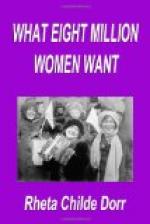“Mr. Speaker,” he said eloquently, “I am devoted to the good women of my State. If I thought that the women of my State wanted this bill passed I would vote for it; but, sir, I have every reason to believe that the good women of my State are opposed to this bill, and therefore;”
At this juncture another member handed to the orator a petition bearing the name of five thousand of the best known women in Georgia. The orator stammered, turned red, felt for his handkerchief, mopped his brow, and continued: “Mr. Speaker, I deeply regret that I did not see this petition yesterday. As it is, my vote is pledged.”
Incidents of this kind have occurred too frequently for the women of the United States to escape their meaning. They have learned that they cannot have everything they want merely by asking for it. Also they have learned, or a large number of them have learned that the old theory of women being represented at the polls by their husbands is very largely a delusion.
The entrance of women in large numbers into labor unions, and into membership in the Women’s Trade Union League is another factor in the increasing interest of American women in suffrage. After a decision of the New York Court of Appeals that the law prohibiting night work of women was unconstitutional, nearly one thousand women book-binders in New York City made a public announcement that they would thenceforth work for the ballot. They had been indifferent before, but this close application of politics to their industrial situation—bookbinding is one of the night trades—made them alive to their own helplessness.
The shirt-waist strike and the garment workers’ strike in New York and Philadelphia, waged so bitterly in 1910, brought great numbers of women into the suffrage ranks. Not only were the women strikers convinced that the magistrates and the police treated them with more contempt than they did the voting men, but they perceived the need of securing better labor laws for themselves. The conviction that women of the wealthier classes would stand by them in securing favorable laws, as they stood by the strikers in the industrial struggle, was a strong lever to turn them towards the suffrage ranks.
[Illustration: MRS. HARRIOT STANTON BLATCH]
The Women’s Trade Union League building, used as strike headquarters in all strikes involving women workers, is a veritable center of suffrage sentiment in New York! One floor houses the offices of the Equality League of Self Supporting Women, of which Harriot Stanton Blatch is founder and president. This society, which is entirely made up of trade and professional workers, claims an approximate membership of twenty-two thousand. A number of unions belong to the League, and there is also a very large individual membership.
In Chicago the suffrage movement and the labor movement is more closely associated than in any other American city. In Chicago, it will be remembered, the Teachers’ Federation is a trade union and is allied to the Central Labor Union. Teachers, almost everywhere denied equal pay with men for equal work, are eager seekers for political power. When, as in Chicago, they are associated with labor, they become convinced suffragists.




